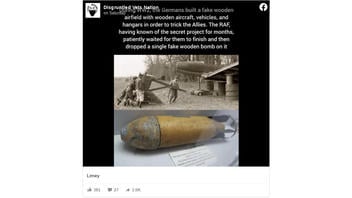
Did Allied bomber pilots drop wooden bombs on German decoy airfields made from wood to let them know they saw through the ruse? While no historical sources can confirm this story beyond a doubt, researchers have compiled eyewitness accounts and other evidence that indicate that this is more than an urban legend.
Versions of this story emerged as early as 1940 and have circulated online for years. It recently re-appeared in a Facebook post (archived here) on July 17, 2021. The post contained a historical photograph of German soldiers building a wooden airplane decoy, a picture of a wooden bomb on display in a museum and the following text:
During WW2, the Germans built a fake wooden airfield with wooden aircraft, vehicles, and hangars in order to trick the Allies. The RAF, having known of the secret project for months, patiently waited for them to finish and then dropped a single fake wooden bomb on it
This is what the post looked like on Facebook at the time of writing:
(Source: Facebook screenshot taken on Wed Jul 21 11:41:29 2021 UTC)
Several versions of this story have been recorded over the years, usually as humorous anecdotes or second-hand accounts. An early example is Berlin Diary: The Journal of a Foreign Correspondent 1934-1941 by William L. Shirer, whose entry for November 27, 1940 is very close to the story shared in the Facebook post:
X tells me a funny one. He says the British intelligence in Holland is working fine. Both sides in this war have built a number of dummy airdromes and strewn them with wooden planes. X says the Germans recently completed a very large one near Amsterdam. They lined up more than a hundred dummy planes made of wood on the field and waited for the British to come over and bomb them. Next morning the British did come. They let loose with a lot of bombs. The bombs were made of wood (597).
The use of wooden decoys during World War II is well recorded. In fact, Shirer records a reversed version of the story for September 23, 1940, minus the wooden bombs: "He relates that the British have built a number of dummy airfields and littered them with wooden planes, but the Germans have most of them spotted by now" (533). Another example of a wooden decoy used to protect important infrastructure was the "Scheinanlage Brasilien," for which the German Wehrmacht rebuilt Stuttgart's main railway station in the nearby village of Lauffen. In a 2018 German-language radio feature, researcher Juergen Lohbeck claims that at least 300 such decoys built by the Germans are registered in a British catalogue from 1944, implying that the strategy did not work very well and most of the fake buildings were eventually uncovered as such.
But does this also mean that the story of the wooden bombs is more than just a tall tale and wartime morale booster? French researcher Pierre Antoine Courouble presented new evidence in his 2009 book Wood for Wood - The Riddle of the Wooden Bombs. For his project, Courouble compiled a list of 303 testimonies and records that tell some version of the story, in which bomber pilots mock the enemy's ill-conceived ruse by dropping wooden bombs on them. The details vary, and most often, these seem to be rogue maneuvers by individual pilots rather than a strategic move by the armed forces.
Courouble also collected the photographs shared in the Facebook post. The image at the top shows German Luftwaffe soldiers exchanging parts on a wooden replica of a Junkers Ju-87 dive bomber. The bottom shows a wooden bomb on display in the Airborne Museum in Sainte-Mère-Eglise in Normandy. Reportedly, it had been taken to the museum by an American pilot who claimed it had been dropped on a fake German airfield in 1944. It is worth noting, however, that these wooden bombs were mainly used as training equipment, as a photograph of a soldier leaning on wooden bomb published by a Belgian magazine in 1939 reveals. The French caption translates as: "The Smoker And The Wooden Bomb; A special section of the British army continues the removal of bombs that were dropped by German aircraft and did not explode. For training, wooden bombs are used instead of projectiles."
In 2020, Courouble followed up on his book with a documentary film that features several eyewitness accounts, among them Werner Thiel who told the following version of the story: As a Lieutenant-Colonel, Thiel was stationed at the Luftkriegsschule III, a Luftwaffe school in Werder near Potsdam in 1942. He was deployed to a training airfield in the village of Borkheide 23 kilometers south of Werder. In 1943, wooden aircraft decoys were set up to protect the airfield from an air raid but the next morning, Thiel only found wooden bombs strewn across the areas - they had "wood for wood" written on them.
Ultimately, this story can only be evaluated based on eyewitness accounts and circumstantial sources, but over the years, researchers have presented compelling evidence that pilots did use wooden bombs on enemy decoys as a sort of practical joke - and likely more than once.















